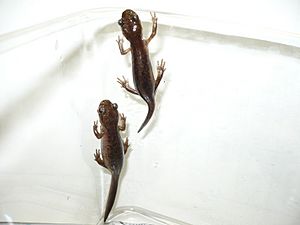Ezo Salamander facts for kids
Quick facts for kids Ezo Salamander |
|
|---|---|
 |
|
| Conservation status | |
| Scientific classification | |
| Kingdom: | |
| Phylum: | |
| Class: | |
| Order: | |
| Family: | |
| Genus: |
Hynobius
|
| Species: |
H. retardatus
|
| Binomial name | |
| Hynobius retardatus (Dunn, 1923)
|
|
The Ezo Salamander or Hokkaido Salamander (Hynobius retardatus) is a special type of salamander. It belongs to a group of animals called the Hynobiidae family. This amazing creature can only be found in Japan, especially on the island of Hokkaido.
Ezo Salamanders love to live in damp, cool places. You can often find them in forests, areas with lots of shrubs, marshes, and swamps. These places offer the perfect environment for them to hunt for food and lay their eggs.
Contents
About the Ezo Salamander
The Ezo Salamander is a fascinating amphibian. Amphibians are animals that can live both on land and in water. They usually start their lives in water, like fish, and then change as they grow. This salamander is a great example of an animal that adapts to its surroundings.
What Do They Look Like?
Ezo Salamanders are usually small to medium-sized. They have smooth, moist skin, which helps them breathe. Their skin can be different shades of brown or black, sometimes with lighter spots. This coloring helps them blend in with their surroundings, like leaves and mud. They have four short legs and a long tail, which helps them swim and move around on land.
Where Do They Live?
These salamanders are endemic to Japan. This means they are found naturally only in that country. Specifically, they live on the northern island of Hokkaido. They prefer places that are wet and cool, like forests with lots of leaf litter, or swampy areas near ponds and streams. These habitats are important for their survival.
What Do They Eat?
Ezo Salamanders are carnivores, which means they eat meat. They are not picky eaters! Their diet usually includes small insects, worms, and other tiny creatures they can find in their habitat. They use their sticky tongues to catch their prey quickly.
Life Cycle of a Salamander
Like many amphibians, Ezo Salamanders have an interesting life cycle.
- They lay their eggs in water, often in small ponds or slow-moving streams.
- The eggs hatch into larvae, which look a bit like tiny fish. These larvae have gills to breathe underwater.
- As they grow, they go through a process called metamorphosis. This is a big change where they lose their gills and develop lungs.
- Once they have lungs, they can live on land, but they still need to keep their skin moist.
Why Are They Important?
Ezo Salamanders play a role in their ecosystem. They help control insect populations by eating them. They also serve as food for other animals, like birds and snakes. Their presence tells us that the environment they live in is healthy.
Conservation Status
The Ezo Salamander is currently listed as "Least Concern" by the International Union for Conservation of Nature (IUCN). This means that, for now, their populations are stable and they are not considered to be in immediate danger of disappearing. However, it's always important to protect their habitats to ensure they continue to thrive.
Images for kids



